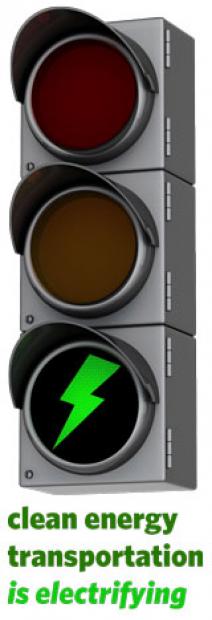This is part of a series of articles on Electrifying Transportation.
I still remember the first documentary I ever saw. My mom, being surprised I hadn’t already seen it, sat me down to watch Who Killed the Electric Car? I was in fifth grade and I remember the personal hurt I felt at the time, not yet fully understanding the implications of the loss of EV innovation. It was my first taste of environmental injustice, and I dreamed of the day that oil cars would die. I didn’t focus much on electric vehicles after that; environmentalism became a thing I agreed with, but by no means lived. As I grew up, I have valued our Earth, and have felt hurt again and again by our degradation of it. I hadn’t taken action to pursue my dream of cars’ demise because I was led to believe it wouldn’t happen in my lifetime.

When I started interning at Climate Solutions I began to see that I was living out a moment that my 10-year-old self dreamed of. Electric cars are everywhere; people are stopping big coal and fighting back. I realized I would not see the end of oil and coal during my lifetime, only if we continue to believe we won’t. The solutions are and have been here. Electric cars were a big part of what changed my thinking. I am not saying that electric cars will save us all, or that they are even the best solution out there, but, there is something unique to the electric car, especially for America. It marks historical moments in the fight against oil and can break our disillusionment that we still need oil.
Oil companies haven’t had to sell themselves to us in a long time because we have continued to believe lies that we need them, and not the other way around. It’s time consumers remind oil companies how wrong they are. And, for me, this starts with making the switch to electric vehicles. I have believed the myth that electric cars are too expensive to be a solution for many to take part in, but after talking to co-workers at Climate Solutions, I have been surprised by EV’s affordability, to the point that I, a broke undergraduate student, have decided to drop my oil guzzler and start the hunt for an EV myself.
I searched the web for the best breakdown of costs and car comparisons to do so, only to realize few have actually published a buying guide for an EV. So here is my own buying guide for your next vehicle (because it’s going to be an EV, right?).
The most obvious immediate expense for an electric vehicle is its sticker price. The potential buyer should keep in mind, however, that there are many ways an EV can save money over time, including reduced maintenance costs and, of course, all the gas that you’ll never have to buy. Starting with the most obvious money saver here, electricity can make the switch worth it alone. Most estimates put the average amount spent on gas a month at around $138. With gas prices here in Seattle going at $3.40 a gallon, I have felt the effect on my wallet moving only four and a half miles farther from work. Those interested in the Nissan Leaf will effectively pay nothing for their energy for the first two years with Nissan’s program that pays for your charging on participating chargers. For others, the cost to charge can vary, sometimes only needing to pay for the parking space. The national average for electricity is $0.12 a kilowatt-hour, leaving your average cost for fueling at $540.00 for the year (driving 15,000 miles). If you are here in Seattle, you will enjoy our electricity prices starting at $0.07 per kWh (putting you at $315 a year). When it comes to maintenance, electric vehicles offer another way to save money. Studies have shown that EVs have the lowest maintenance and repair costs, at 3 to 4 cents per mile versus 6 cents per mile for gas-powered cars.
How clean is this energy?
During my car search, some folks have asked me whether electric vehicles are even better for the environment. The short answer is, absolutely. The long answer? Today’s gas engines have a maximum thermal efficiency of 25% to 50% (25% being typical, while 50% is ideal) when first purchased. From there, the engine degrades, making for even less efficient transfer of energy. What does this mean? Up to 75% of the energy that is produced by burning fuel, in your brand new car, is lost, in the form of heat and toxins into our atmosphere. Batteries, on the other hand, have an efficiency level of around 80% with most car companies guaranteeing at least 70% efficiency for the first 8 years. In Seattle, 92% of electric energy produced comes from wind or hydroelectric power and only 1% produced from coal, leaving a Seattle EV driver burning 99% less coal and utilizing 45% more energy on their daily commute than a gas car driver.
I have also heard fears that discarded batteries will only fill up more landfills, which gas cars do anyway. But companies have begun to take address this section of the EV life cycle through recycling batteries, which contain a number of high-demand metals.
A different kind of Range Rover; how far can your EV get you?
Batteries and range (the number of miles a car can drive on one charge) are often a concern for people when talking about electric vehicles. Most manufacturers now offer an eight-year or 100,000-mile warranty on batteries, covering not only complete failure, but also degradation, promising 70% efficiency, or 45% greater efficiency than a brand new, gas car Many say they are afraid that an EV could leave them stranded at the end of its range tether, without any way to charge. The Nissan Leaf’s range is only of 107 miles, Tesla’s Model 3 is ranged at 220 miles, with an option for the long-range model at 310 miles, and the Chevy Bolt is ranged at 238 miles. With most hybrids ranging from 450 to 600-mile ranges, and most cars ranging around 300 miles, electric vehicles do have a shorter range. But with a growing neetwork of charging stations, charging is becoming easier and more accessible. For example, one can now drive an EV from British Columbia to Baja California on the West Coast Green Highway.
With many apartment buildings providing chargers in their garages, not to mention business parking lots, streets, and city parking lots adding charging stations, you may find EV’s are the best way to find a parking space in Seattle. Plus, charging has become much faster, with direct current (DC) chargers charging up to 80 % in 30 minutes. In Seattle, a typical commute is around 9 miles, one-way. If you were only driving to work 5 days a week, this would come out to 90 miles, meaning even a Leaf owner could get by only charging once a week to get to and from work. Not all to say that EVs aren’t less convenient right now, but this becomes a personal question of how often you actually drive more than 100 miles a day, and whether it would be cheaper to rent a car for that trip you want to take this summer than to pay for gas year round.
Where to charge?
When I first started researching EVs, there was notable neglect from private companies to include plug-ins equally around the city. There still is a very obvious desert of public charging stations east of 15th Ave. and south of I-90. Seattle City light seems to be responding to this problem, along with their plan to roll out their own fleet of electric vehicles. The goal of this plan is to add charging stations where there are few DC fast chargers and EV owners, as well as areas subject to high pollution. City Light has committed to installing 20 public DC fast charging stations on 15 sites. With Seattle city leadership, we can expect to see a lot more electric vehicles on the road with their Drive Clean Seattle initiative. The city has also promised to electrify the city's fleet of cars and install 200 new charging stations by the end of 2018. Meanwhile, you can find a charging station using a number of different apps, including PlugShare, ChargePoint, Open Charge Map, ChargeHub, and EZ-EV. Signage in certain areas is lacking, making it hard to find charging stations without apps at times. Also, there still is no standardized way to pay for public charging, making long-distance driving frustrating.
Sticker shock
So you could be saving a significant amount each year on fueling your vehicle, get more out of the energy you are putting into your car, make your environment more livable while doing so, and your maintenance costs could be cut in half.... but aren’t EVs expensive up front? Only at first glance, but between state incentives and federal incentives, EVs can be considerably affordable.
Let’s look at the Nissan Leaf, though there are many EVs out there that you should look into if you are serious about buying or leasing. Here and here are lists of mainstream and startup companies that sell EVs, respectively.
At sticker price, The 2017 Leaf starts at $30,680. The current Federal Tax incentive will take $7,500 off of that, leaving you at $23,180, even before your State incentives. In Washington, Jay Inslee recently signed legislation exempting sales tax on the first $32,000 of the selling price of an electric vehicle which would save a new Leaf buyer $3,068. Note that if your business is looking for a new car, you can be eligible for tax incentives from $25,000 to $100,000 (up to 50% of cost), depending on the size of the vehicle being purchased. You can find more incentives for your own state here. For those looking for at home charging, Puget Sound Energy offers a $500 rebate to customers to purchase and install qualified Level 2 chargers. While there are strides to be made for the affordability and accessibility of electric vehicles, their current rate of depreciation is pretty beneficial to those whose budget does not allow for a new car. One can find a 2013 Nissan Leaf for between $7,000 and $9,000.
Lease or buy?
So should I lease or should I buy? I spoke with Heather, an EV owner, and she advised me that leasing is the better option: “The technology is changing so rapidly (the mileage per charge is increasing), the value of the vehicle will not only be low, but there will be an option for me that will have a much longer range when my lease is up.” There are now many EV options for gas car owners looking to trade in for an upgrade. GM, Volkswagen, Ford, Daimler (makers of Mercedes), BMW, and Toyota have all promised fully electric vehicles to hit the market soon (with GM and Volkswagen promising to phase out their gas cars along the way). "General Motors believes the future is all-electric." Said Mark Reuss, the president of General Motors North America. GM is now selling a two-seat EV for only $5,300 in China, where it now sells more cars than it does in the States. They will be rolling out 10 more electric or hybrid electric cars there in the next two years. It might be time to rethink what driving American means.
Let’s try to keep up, shall we?
A recent AAA survey revealed that 1-in-6 Americans are likely to choose an electric vehicle, with most motivated by their lower long-term costs. So why don’t we have more on the street? The perception of electric vehicles here feels charged; we hold a lot of discourse around the accessibility of an EV and what it means to others when we drive them. The benefit of owning an EV, economic and otherwise, just makes good sense. As Heather told me, she sees owning one, “as an investment in technology that has the potential to fight climate change.”
While we fight over climate change and continue buying massive SUV’s that inevitably hurt our checkbooks, other countries are making the switch mandatory. The UK has said in July they have plans to ban sales of new gasoline and diesel cars, and by 2050 all cars on the road will need to have zero emissions. France has joined them, promising to ban gas and diesel powered vehicles by 2040. India has said that by 2030 every vehicle sold in the country should be electric. 40% of all cars sold in Norway last year were electric or hybrid vehicles and they have targeted the selling of only zero-emission vehicles by 2025. Chancellor Angela Merkel of Germany has hinted it is only a matter of time that they follow suit, with some German towns attempting to introduce diesel bans on their own. China is currently working on a timetable for banning gas and diesel-fueled vehicles. Austria, Denmark, Ireland, Japan, the Netherlands, Portugal, Korea and Spain have all given official targets for EVs along with California, Colorado, Illinois, Massachusetts, New Mexico, New York, Vermont, and here in Washington. It is time that we all get on board to be a part of this global innovation.
In my quest to learn all I could about EVs so I'll be ready when the time arrives to make a purchase, EV owners often had the best advice: "It’s important that it fits your lifestyle. The range has to work for your daily commute, and for it to be truly convenient, having a home charger is a must. That being said, it’s also totally worth rearranging your life a bit in order to make an EV work for you. The more that are increasingly on the road, the lower the price, the better the technology gets, the more charging options we’ll have. [Also,] The Leaf has a lot of power—you can zip if you need to!"
So there you have it! The electric car is back and better than before. Ever-expanding charging networks mean there are more directions one can drive—but the technology itself is driving hard in one single direction—the increasing electrification of our modes of transportation, and our progress towards a goal of clean energy everywhere. Goodbye gasoline!

